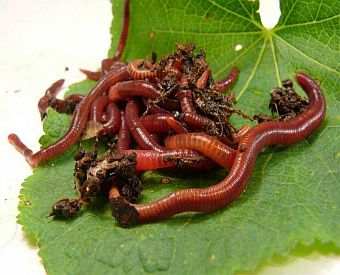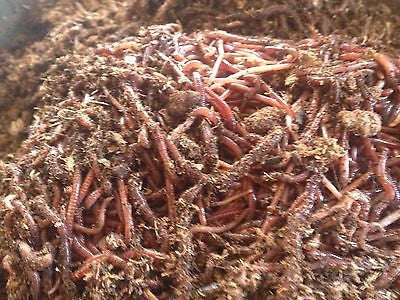Organic Composting with Red Wiggler Worms - Increase Your Garden's Growth
Organic Composting with Red Wiggler Worms - Increase Your Garden's Growth
Blog Article
Maximizing the Perks of Red Wiggler Worms: A Comprehensive Guidebook for Home Gardeners and Urban Farmers
In the realm of sustainable gardening techniques, red wiggler worms stand as unrecognized heroes, silently transforming organic waste into nutrient-rich spreadings that can work marvels for dirt health. As home gardeners and urban farmers increasingly seek eco-friendly and cost-effective ways to improve their yards, the potential benefits of utilizing the power of red wigglers can not be overemphasized. From lessening cooking area waste to growing healthier plants, the use of these simple creatures provides a variety of benefits. By exploring the intricacies of how to successfully take care of and make best use of the advantages of red wiggler worms, people can open a wealth of opportunities for improving the sustainability and productivity of their horticulture ventures.
Comprehending Red Wiggler Worms
Red Wiggler worms, renowned for their efficient composting capabilities, are a species of earthworms widely used in vermiculture methods. These worms, medically understood as Eisenia fetida, prosper in decaying organic product, making them ideal candidates for composting (Red Wiggler Worms). Red Wigglers are ravenous eaters, with the ability of eating their own weight in natural waste daily. Their gastrointestinal procedure breaks down raw material right into nutrient-rich castings, which are a beneficial source for enhancing soil and advertising plant development.
One secret attribute of Red Wiggler worms is their reproductive price. These hermaphroditic animals possess both female and male reproductive organs, permitting them to duplicate quickly under beneficial conditions. A fully grown Red Wiggler can produce several offspring in a short period, making certain a consistent populace within a composting system.

Establishing a Worm Bin
When establishing a worm container for vermiculture objectives, correct prep work and focus to information are essential for creating a favorable atmosphere for Red Wiggler worms,. Begin by choosing an ideal container for your worm container. This can be a plastic or wooden container with a cover to keep dampness levels and safeguard the worms from light. Ensure that the container has water drainage holes at the bottom to avoid waterlogging.

Place the worm container in an awesome, dark location away from direct sunshine and extreme temperatures. By following these steps, you can set up a flourishing worm container that will efficiently check process natural waste right into nutrient-rich vermicompost for your yard.
Feeding and Preserving Worms
Making certain a balanced and nourishing diet plan is essential for the health and productivity of Red Wiggler worms in a vermiculture system. It is crucial to stay clear of feeding them citrus fruits, onions, garlic, milk items, meat, and oily foods as these can be damaging to the worms or create undesirable smells in the bin.
Appropriate dampness levels are additionally critical for the well-being of Red Wiggler worms. By carefully checking their diet, wetness, and environmental problems, home gardeners and metropolitan farmers can maintain a healthy and balanced and productive Red Wiggler worm populace for composting objectives.
Collecting Worm Castings
To effectively draw out nutrient-rich worm spreadings from the vermicompost, a methodical harvesting procedure is crucial for maximizing the composting benefits. The first action in harvesting worm spreadings is to encourage the worms to move to one side of the bin.
After the spreadings have been collected, it is very important to divide any continuing to be worms from the spreadings to avoid harming them throughout storage space or application. One reliable method is to produce conical piles of castings under bright light. Worms will intuitively move away from the light, enabling easy separation and elimination.
Lastly, the gathered worm castings should be kept in a trendy, dark, and dry place to preserve their top quality and performance as a nutrient-rich dirt amendment. By following these actions, home garden enthusiasts and metropolitan farmers can maximize the benefits of red wiggler worms in their vermicomposting systems.
Utilizing Worm Castings in Gardening
The consolidation of nutrient-rich worm castings right into garden dirt can significantly boost plant growth and general soil health and wellness. Worm castings, also referred to as vermicast, are an all-natural plant food generated by red wiggler worms as they damage down organic issue. These castings are abundant in necessary nutrients like nitrogen, phosphorus, potassium, and beneficial germs that promote plant growth and improve dirt framework.
When using worm spreadings in horticulture, it is essential to Check Out Your URL blend them completely right into the soil or utilize them as a top dressing around plants. The slow-release nature of worm castings makes sure a steady supply of nutrients to plants in time, reducing the threat of nutrient leaching and promoting long-lasting dirt fertility. Additionally, worm castings help enhance soil aeration, water retention, and microbial activity, developing a healthy and balanced environment for plant roots to flourish.

Conclusion
In final thought, the application of red wiggler worms in home gardening and metropolitan farming can substantially profit dirt health and plant growth. By recognizing exactly how to establish and maintain a worm bin, feed the worms effectively, and harvest their nutrient-rich castings, gardeners can make best use of the benefits of these earthworms. Incorporating worm castings into horticulture practices can boost dirt fertility and total plant efficiency. On the whole, red wiggler worms offer a sustainable and effective remedy for boosting yard and ranch yields.
In the world of lasting gardening practices, red wiggler worms stand as unsung heroes, quietly transforming organic waste right into nutrient-rich spreadings that can function marvels for dirt health.When establishing a worm container for vermiculture objectives, appropriate preparation and interest to detail are important for creating a favorable atmosphere for Red Wiggler worms. The very first action in collecting worm spreadings is to urge the worms to move to one side of the bin. Worm castings, likewise understood as vermicast, are a natural fertilizer created by red wiggler worms as they break down natural Recommended Reading issue. By recognizing exactly how to set up and keep a worm bin, feed the worms effectively, and collect their nutrient-rich castings, garden enthusiasts can make the most of the benefits of these earthworms.
Report this page